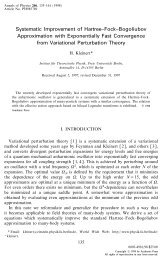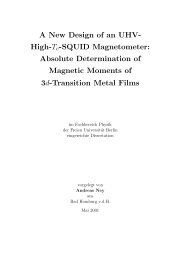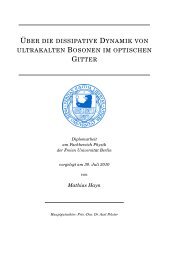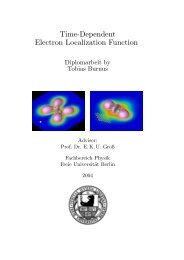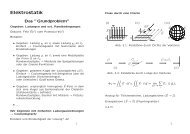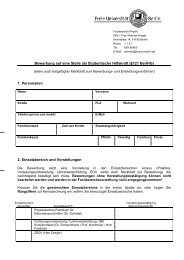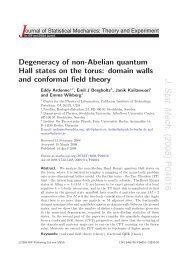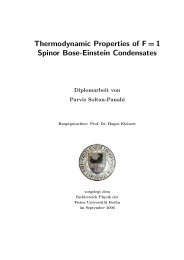Diploma thesis
Diploma thesis
Diploma thesis
Create successful ePaper yourself
Turn your PDF publications into a flip-book with our unique Google optimized e-Paper software.
3.1 Static solutions of Schrödinger equation<br />
|A a | =<br />
{<br />
2e −2ka I,1 L [ sin 2k<br />
a<br />
R,1 (w − L)<br />
k a R,2<br />
− sinh 2ka I,1(w − L)<br />
+ cos 2ka R,1(w − L) − cosh 2k a I,1(w − L)<br />
cos 2k a R,2w − cosh 2k a I,2w<br />
k a I,2<br />
( sinh 2k<br />
a<br />
I,2 w<br />
k a I,2<br />
− sin )]} −<br />
1<br />
2ka 2<br />
R,2w<br />
. (3.11)<br />
kR,2<br />
a<br />
Thus we can fix them only up to a phase factor e iϕ , ϕ ∈ [0, 2π). Knowing the particular wave<br />
function it is possible to calculate the density ρ = |ψ(x)| 2 and the current j(x) from (2.5) at some<br />
fixed time. The symmetric and antisymmetric wave functions (3.7) are continuous at x = ±w and<br />
±L. Since (2.9) yields that the second derivative of the wave function ψ ′′ only has a finite jump<br />
discontinuity at x = ±w and an infinite one at ±L, its first derivative ψ ′ has to be continuous<br />
at ±w, too, but not at ±L. Thus we obtain a relation between k 1 and k 2 and thus via (3.8) an<br />
additional condition the energy E has to fulfill, which is our quantization condition<br />
⎡ √ ⎤<br />
√ 2M<br />
Es cot ⎣(w − L)<br />
2 Es ⎦ + √ ⎡<br />
⎤<br />
E s + iC tan ⎣w√<br />
2M<br />
2 (Es + iC) ⎦ = 0 (3.12)<br />
in the symmetric case and in the antisymmetric case<br />
⎡ √ ⎤<br />
√ 2M<br />
Ea cot ⎣(w − L)<br />
2 Ea ⎦ − √ ⎡<br />
⎤<br />
E a + iC cot ⎣w√<br />
2M<br />
2 (Ea + iC) ⎦ = 0. (3.13)<br />
The solutions of these two transcendental equation allow to determine all important physical<br />
quantities E, ρ, j etc. of the problem.<br />
For consistency one can evaluate the real limit by setting C = 0, which directly yields<br />
⎛<br />
⎞<br />
⎛<br />
cos ⎝√<br />
2M<br />
2 Es L⎠ = 0 and sin ⎝√<br />
2M<br />
2 Es L⎠ = 0. (3.14)<br />
⎞<br />
This can only be fulfilled by real arguments, since cosh(x) has no real root and cos(x) and sin(x)<br />
no mutual one:<br />
cos(x + iy) = cos(x) cosh(y) − sin(x) sinh(y) = 0 ⇒ x =<br />
(<br />
n + 1 )<br />
π, y = 0 (3.15)<br />
2<br />
sin(x + iy) = sin(x) cosh(y) + cos(x) sinh(y) = 0 ⇒ x = nπ, y = 0. (3.16)<br />
Therefore E has to be real and is given by<br />
E s = 2 π 2 (n + 1 ) 2<br />
2ML 2 2<br />
and E a = 2 π 2<br />
2ML 2 n2 . (3.17)<br />
(<br />
This is followed by k1 s = k2 s =: kn s = π L n +<br />
1<br />
2<br />
)<br />
and k<br />
a<br />
1 = k a 2 =: k a n = π L n and the identities 9




